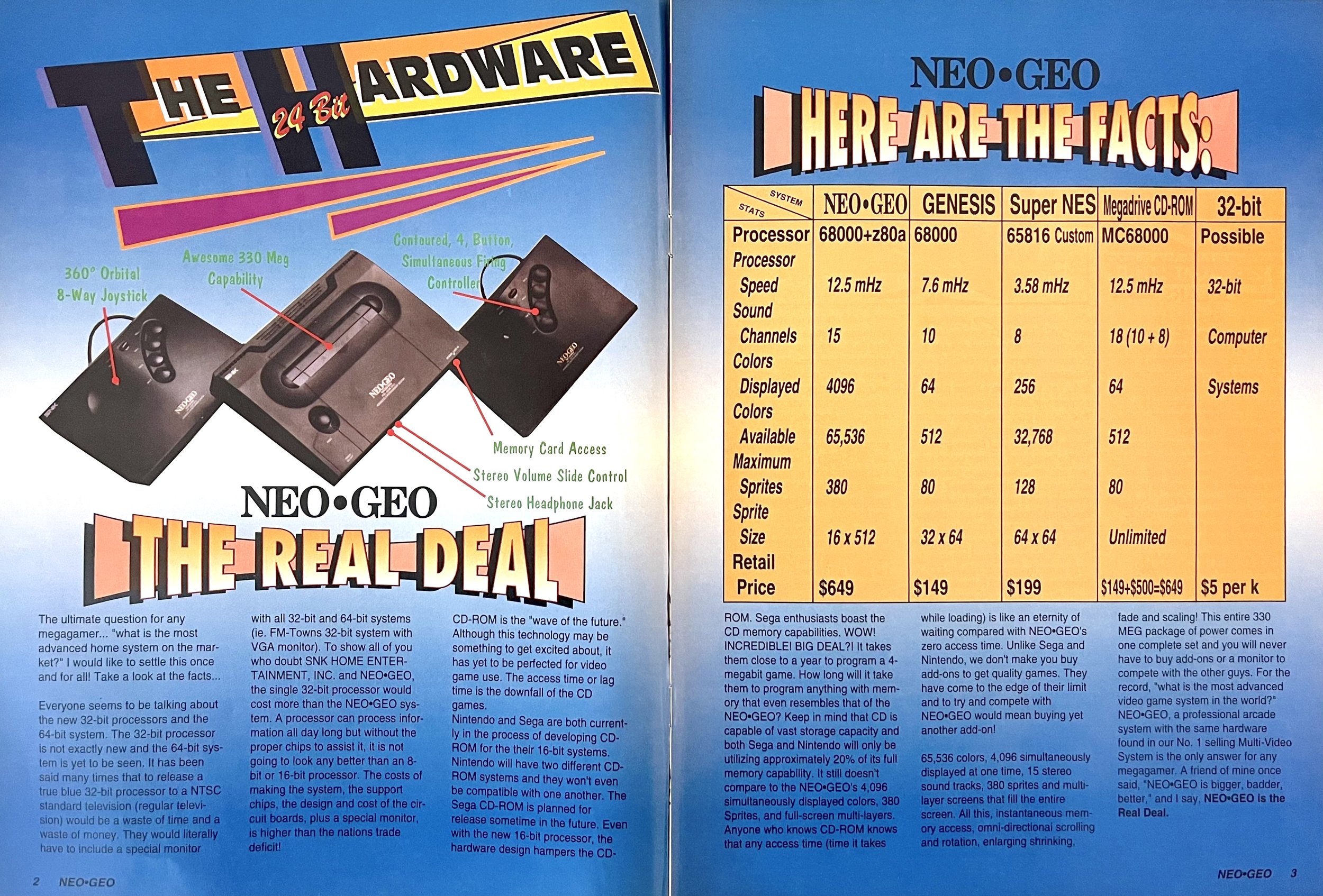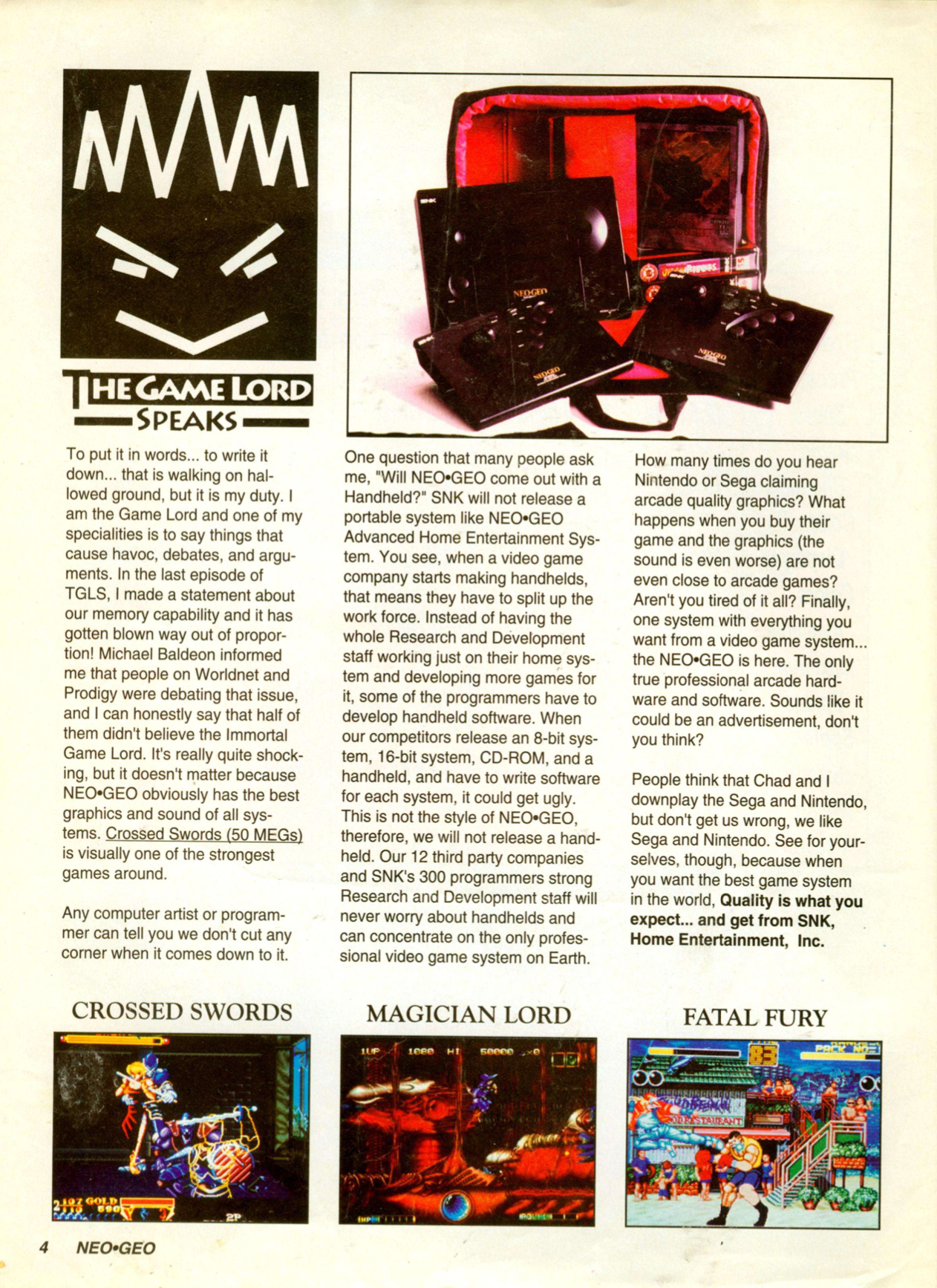Neo Geo - Bigger, Badder, Better
The first time I got my hands on a Neo Geo AES system was in a local import shop circa 1993. They had three systems lined up in a row and you could pay $2 to play one for 20 minutes. Which, in retrospect, was a pretty good deal.
The system was never officially released in Australia, but I knew all about it from reading import copies of EGM magazine. Most notably, the Bigger, Badder, Better supplement about the system included with the February 1992 issue of EGM (#31).
Which is something I had completely forgotten about until I went back home for the holidays and found said supplement buried amongst my old gaming magazines. So, let’s take a closer look.
The Real Deal
The supplement begins with a two page comparison of the Neo Geo vs other systems on the market. The sales pitch goes in hard. Here are a couple of highlights
The feature argues that a true 32 bit system is pointless without a dedicated monitor to view it on. “They would literally have to include a special monitor with all 32bit and 64bit systems.” Also, it would be expensive to produce a 32 bit system and once you factor in “circuit boards, chips and a special monitor,” the total costs would be “higher than the nation’s trade deficit.” Indeed.
Also, CD-ROM technology isn’t where it needs to be, you know, with the access lag. That’s a fair point, but did you know that, “Nintendo will have two different CD-ROM systems and they won’t even be compatible with one another.” Also, it will take forever to program any games and even then they’ll only use, like, 20% of the storage capacity.
Suffice to say, you’d have to be mentally deficient to want a 32bit system, or a CD-add on for your Sega / Nintendo, when the 24-bit Neo Geo is available to purchase right now. Or so the article implies…
The Game Lord Speaks
The Game Lord was SNK’s attempt to create a trusted ‘personality’ to help shill the Neo Geo. Think Major Nelson for Microsoft / Xbox. But with, like, more edge… “I am the Game Lord and one of my specialities is to say things that cause havoc, debates, and arguments.”
I still have no idea who this person was… let me Google that real quick…*Sigh* All I got was a bunch of hits for the 1991 Neo Geo Game Magician Lord. So if anyone knows more about the identity / history of The Game Lord please ‘at’ me via @American80s.
Anyway, you can read the column above. I like that he alludes to online feuds on what I can only assume are early bulletin boards, “People on Worldnet and Prodigy were debating the issue.” Simpler times…
Twice the Fun
Did you know you can hook up two Neo Geo systems and play head-to-head. So just dust off that spare Neo Geo and knock yourself out playing League Bowling.
Moving on…
The Games
All snark aside, having the ability to play arcade games in your home - not watered down ports - was an amazing concept in the 90s. I certainly spent a lot of time and money in the arcades (and at local corner shops), playing earlier titles like Ninja Combat, Nam-1975, Sengoku, Baseball Stars, World Heroes and more.
Owning a Neo Geo AES as a kid was never going to happen in my household, but if you wanted to make your friends insanely jealous this would have done it.
Real arcade games from Neo Geo
Kids today will never understand the appeal of a bright red Neo Geo arcade cabinet parked outside a local fish n chips shop, Blockbuster video, or suburban mall.
This Top 20 list seems to be based on industry ratings (rather than revenue/popularity). It’s no surprise to see Street Fighter 2 at the top, but it’s vaguely interesting to look at the ratings vs the game’s distribution. I remember Ninja Combat was everywhere back in the day, whereas I don’t think I ever encountered EightMan (which is clearly ranked higher)… ¯\_(ツ)_/¯
Accessories
Another fun fact. Did you know a Neo Geo memory card could hold 19-27 games saves?
Having the ability to transfer saves between your home console and the arcade cabinets was both revolutionary and super cool. One of these would have run you $29 back in the day. Adjusted for inflation that’s $65 in today’s money.
Video Games aren’t Kidstuff Anymore
I’m not sure who the Neo Geo was aimed at. Retailing for $650 US (about $1500 adjusted for inflation) it was several times the price of the Super Nintendo or Mega Drive / Genesis. And that’s before you factor in the games at $200 a pop ( $450 in today’s money!).
So I guess the short answer is rich people. Or 20-something die-hards with cash to spare. But that older demographic wouldn’t really be ‘created’ until the Playstation came around with its nightclubs, pills, and Future Sound of London soundtracks.
So while it may well have been bigger, badder, better, the Neo Geo would always remain out of reach, The ‘Rolls Royce of home consoles’ actually more like a teenage fever dream…
In the end, the Neo Geo AES system sold about 1.5 million units worldwide. But if you wanted the real arcade experience at home this was it…








